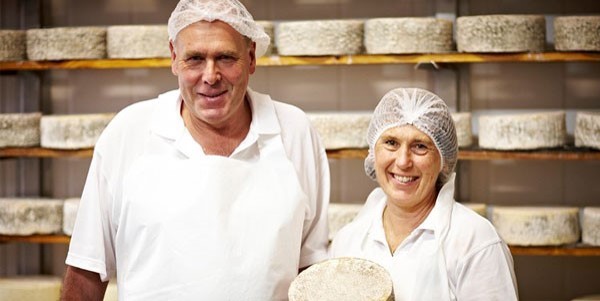A Preference of Credibility: Floridia Cheese Melbourne and Its Craftsmanship
A Preference of Credibility: Floridia Cheese Melbourne and Its Craftsmanship
Blog Article
Opening the Secrets of Artisanal Cheese Making: A Step-by-Step Do It Yourself Guide
In the world of culinary workmanship, artisanal cheese making stands as a testament to the fragile equilibrium between practice and advancement. Each step in the process, from selecting the best milk to perfecting aging techniques, holds within it a wide range of expertise gave through generations. As we start this journey to demystify the art of creating charming cheeses, we are encountered with a tapestry of abilities and keys waiting to be unraveled. Join us as we explore the complexities of this ancient craft, where scientific research, art, and perseverance assemble to create flavors that tantalize the senses.
Selecting the Right Milk
When embarking on the journey of artisanal cheese production, the option of milk plays a crucial duty in determining the quality and characteristics of the end product. The kind of milk picked impacts the taste, structure, and generally account of celebrity. Raw milk, right from the pet, is chosen by numerous artisanal cheesemakers as a result of its special blend of enzymes, microorganisms, and taste compounds. However, making use of raw milk includes regulations and dangers, making pasteurized milk a more secure option for beginners.
When choosing milk for cheese production, it is essential to consider the fat content. Greater fat content in milk can cause a creamier and richer cheese, while lower fat web content might result in a drier and firmer structure. In addition, the resource of the milk, whether from cows, goats, sheep, or buffalo, adds distinct tastes and features to celebrity (Floridia Cheese). Each type of milk brings its own nuances, enabling a large range of cheese ranges to be crafted based on the selected milk. Ultimately, the option of milk is a basic decision that establishes the foundation for an effective artisanal cheese-making endeavor.
Culturing and Coagulating
To start the cheese-making process, the critical actions of culturing and coagulating must be very carefully carried out to transform milk right into curds and whey. Culturing involves introducing advantageous germs to the milk, which then begins the fermentation process. These germs transform lactose (milk sugar) right into lactic acid, producing the acidic atmosphere essential for coagulation. The type of culture made use of can significantly impact the flavor, appearance, and ripening of the final cheese product.

The timing and temperature control during culturing and coagulation are vital variables that influence the last outcome of the cheese. Correct implementation of these actions is necessary to guarantee the desired texture, taste, and uniformity of the artisanal cheese being generated.
Draining Pipes and Pushing Curds
After the milk healthy proteins have actually coagulated and the curds have actually been cut to release whey, the next essential action in artisanal cheese making entails draining and pushing the curds to attain the wanted texture and consistency of the final cheese product. Draining pipes is the procedure of dividing the curds from the whey. This can be done by moving the curds into a cheesecloth-lined colander or mold and mildew and permitting the whey to drain off naturally. The moment for draining can differ depending upon the kind of cheese being made and the preferred wetness material.
Pushing aids expel any remaining whey and compacts the curds to form a solid cheese wheel. Proper draining and pushing are essential actions that substantially influence the high quality and attributes of the artisanal cheese being generated.
Aging and Flavor Strategies
Implementing precise aging and flavoring methods is essential in improving the depth and intricacy of artisanal cheeses, raising their taste profiles to elegant degrees of improvement and sophistication. Aging plays a crucial role in creating the unique flavors and textures that identify artisanal cheeses. Throughout the aging process, cheeses are stored in carefully regulated atmospheres where elements such as humidity, temperature level, and air flow are adjusted to encourage the development of beneficial molds and bacteria. This regulated setting permits celebrity to grow slowly, creating abundant tastes and intricate scents.
Seasoning strategies also contribute substantially to the last preference of artisanal cheeses. Cheesemakers may go to my site choose to present added tastes by incorporating components such as natural herbs, seasonings, or also fruits into the cheese throughout the manufacturing procedure. Additionally, some cheeses are cleaned or rubbed with different fluids, such as brine or alcohol, to enhance their appearances and flavors.
Covering and Storing Cheeses

Conclusion
In verdict, grasping the art of artisanal cheese making involves thoroughly selecting the ideal milk, adhering to accurate culturing and coagulating procedures, draining and pushing curds effectively, and using different aging and flavor methods. Bear in mind to cover and save your cheeses effectively to ensure optimal flavor and texture advancement.
Each type of milk brings its own nuances, allowing for a broad variety of cheese ranges to be crafted based on the picked milk.After the milk healthy proteins have actually coagulated and the curds have actually been reduced to launch whey, the following crucial step in artisanal cheese making includes draining and pushing the curds to attain the desired texture and consistency of the last cheese item. The majority of cheeses should be wrapped in wax paper or cheese paper to allow them to breathe while shielding them from drying out. For cheeses that require to proceed aging, such as bloomy skins or washed rinds, ensure they are stored in an amazing setting like a cheese cavern or a fridge set to the appropriate temperature level. By paying focus to the covering and storage of artisanal Check Out Your URL cheeses, cheese manufacturers and fanatics can protect the integrity of these delicacies and totally appreciate their complicated flavors.
Report this page